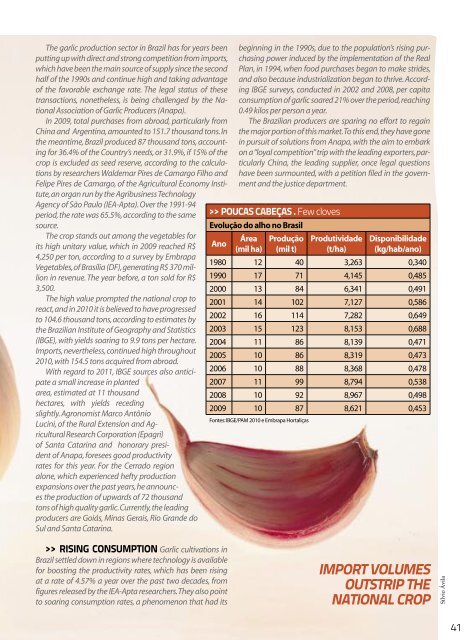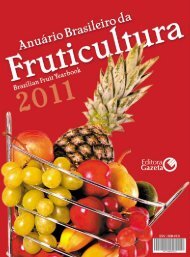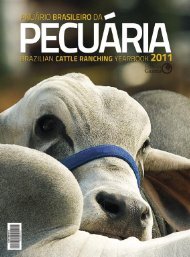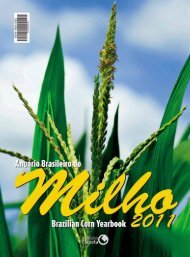tradicionalmenteinovador - Brazil Buyers & Sellers
tradicionalmenteinovador - Brazil Buyers & Sellers
tradicionalmenteinovador - Brazil Buyers & Sellers
You also want an ePaper? Increase the reach of your titles
YUMPU automatically turns print PDFs into web optimized ePapers that Google loves.
The garlic production sector in <strong>Brazil</strong> has for years been<br />
putting up with direct and strong competition from imports,<br />
which have been the main source of supply since the second<br />
half of the 1990s and continue high and taking advantage<br />
of the favorable exchange rate. The legal status of these<br />
transactions, nonetheless, is being challenged by the National<br />
Association of Garlic Producers (Anapa).<br />
In 2009, total purchases from abroad, particularly from<br />
China and Argentina, amounted to 151.7 thousand tons. In<br />
the meantime, <strong>Brazil</strong> produced 87 thousand tons, accounting<br />
for 36.4% of the Country’s needs, or 31.9%, if 15% of the<br />
crop is excluded as seed reserve, according to the calculations<br />
by researchers Waldemar Pires de Camargo Filho and<br />
Felipe Pires de Camargo, of the Agricultural Economy Institute,<br />
an organ run by the Agribusiness Technology<br />
Agency of São Paulo (IEA-Apta). Over the 1991-94<br />
period, the rate was 65.5%, according to the same<br />
source.<br />
The crop stands out among the vegetables for<br />
its high unitary value, which in 2009 reached R$ Ano<br />
4,250 per ton, according to a survey by Embrapa<br />
Vegetables, of Brasília (DF), generating R$ 370 million<br />
in revenue. The year before, a ton sold for R$<br />
3,500.<br />
The high value prompted the national crop to<br />
react, and in 2010 it is believed to have progressed<br />
to 104.6 thousand tons, according to estimates by<br />
the <strong>Brazil</strong>ian Institute of Geography and Statistics<br />
(IBGE), with yields soaring to 9.9 tons per hectare.<br />
Imports, nevertheless, continued high throughout<br />
2010, with 154.5 tons acquired from abroad.<br />
With regard to 2011, IBGE sources also anticipate<br />
a small increase in planted<br />
area, estimated at 11 thousand<br />
hectares, with yields receding<br />
slightly. Agronomist Marco Antônio<br />
Lucini, of the Rural Extension and Agricultural<br />
Research Corporation (Epagri)<br />
of Santa Catarina and honorary president<br />
of Anapa, foresees good productivity<br />
rates for this year. For the Cerrado region<br />
alone, which experienced hefty production<br />
expansions over the past years, he announces<br />
the production of upwards of 72 thousand<br />
tons of high quality garlic. Currently, the leading<br />
producers are Goiás, Minas Gerais, Rio Grande do<br />
Sul and Santa Catarina.<br />
beginning in the 1990s, due to the population’s rising purchasing<br />
power induced by the implementation of the Real<br />
Plan, in 1994, when food purchases began to make strides,<br />
and also because industrialization began to thrive. According<br />
IBGE surveys, conducted in 2002 and 2008, per capita<br />
consumption of garlic soared 21% over the period, reaching<br />
0.49 kilos per person a year.<br />
The <strong>Brazil</strong>ian producers are sparing no effort to regain<br />
the major portion of this market. To this end, they have gone<br />
in pursuit of solutions from Anapa, with the aim to embark<br />
on a “loyal competition” trip with the leading exporters, particularly<br />
China, the leading supplier, once legal questions<br />
have been surmounted, with a petition filed in the government<br />
and the justice department.<br />
>> POUCAS CABEÇAS . Few cloves<br />
Evolução do alho no Brasil<br />
Área<br />
(mil ha)<br />
Produção<br />
(mil t)<br />
Produtividade<br />
(t/ha)<br />
Disponibilidade<br />
(kg/hab/ano)<br />
1980 12 40 3,263 0,340<br />
1990 17 71 4,145 0,485<br />
2000 13 84 6,341 0,491<br />
2001 14 102 7,127 0,586<br />
2002 16 114 7,282 0,649<br />
2003 15 123 8,153 0,688<br />
2004 11 86 8,139 0,471<br />
2005 10 86 8,319 0,473<br />
2006 10 88 8,368 0,478<br />
2007 11 99 8,794 0,538<br />
2008 10 92 8,967 0,498<br />
2009 10 87 8,621 0,453<br />
Fontes: IBGE/PAM 2010 e Embrapa Hortaliças<br />
>> RISING CONSUMPTION Garlic cultivations in<br />
<strong>Brazil</strong> settled down in regions where technology is available<br />
for boosting the productivity rates, which has been rising<br />
at a rate of 4.57% a year over the past two decades, from<br />
figures released by the IEA-Apta researchers. They also point<br />
to soaring consumption rates, a phenomenon that had its<br />
IMPORT VOLUMES<br />
OUTSTRIP THE<br />
NATIONAL CROP<br />
Sílvio Ávila<br />
41





